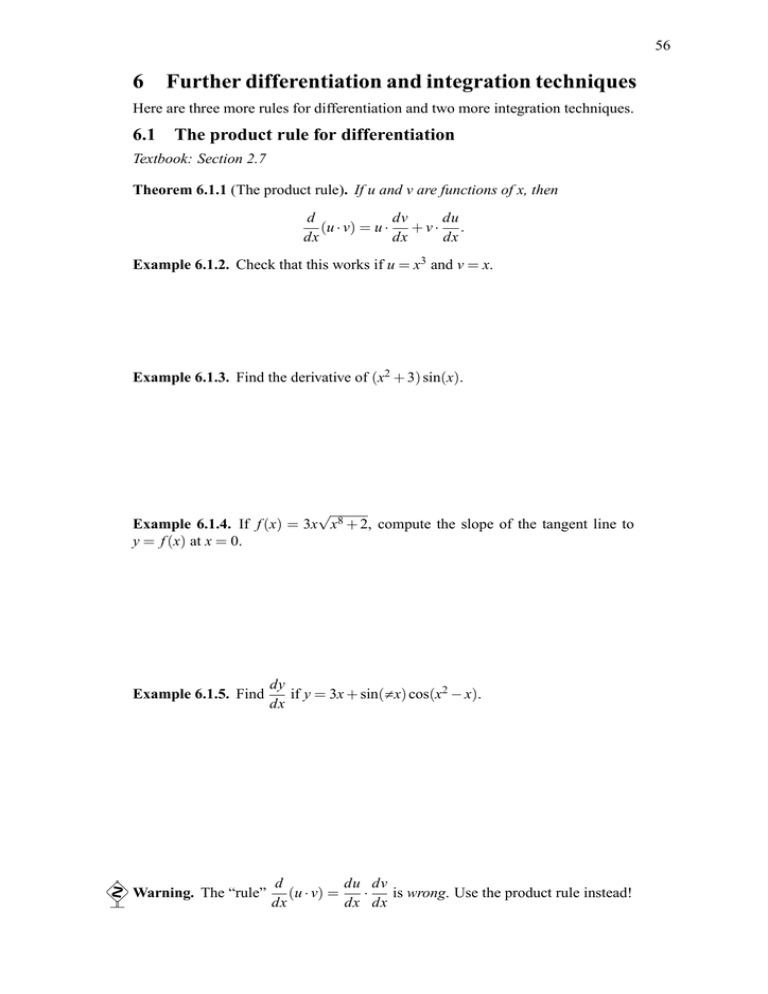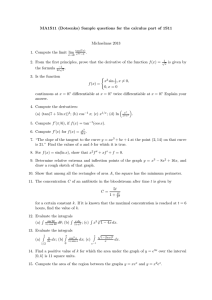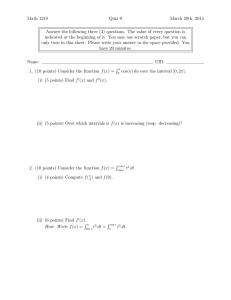6 Further differentiation and integration techniques 6.1 The product rule for differentiation
advertisement

56 6 Further differentiation and integration techniques Here are three more rules for differentiation and two more integration techniques. 6.1 The product rule for differentiation Textbook: Section 2.7 Theorem 6.1.1 (The product rule). If u and v are functions of x, then d dv du (u · v) = u · + v · . dx dx dx Example 6.1.2. Check that this works if u = x3 and v = x. Example 6.1.3. Find the derivative of (x2 + 3) sin(x). √ Example 6.1.4. If f (x) = 3x x8 + 2, compute the slope of the tangent line to y = f (x) at x = 0. Example 6.1.5. Find dy if y = 3x + sin(π x) cos(x2 − x). dx Warning. The “rule” d (u · v) = du · dv is wrong. Use the product rule instead! dx dx dx 57 6.2 The quotient rule for differentiation Textbook: Section 2.7 Theorem 6.2.1 (The quotient rule). If u and v are functions of x, then dv v · du d u dx − u · dx . = dx v v2 Example 6.2.2. Check that this works if u = x3 and v = x. Example 6.2.3. Find the derivative of sin(x) . x2 + 3 3x Example 6.2.4. If f (x) = √ , find the slope of the tangent line to y = f (x) x8 + 2 at x = 0. Example 6.2.5. The function tan is defined by tan(t) = d sin(t) tan(t) ? . What is cos(t) dt . Warning. The “rule” d (u/v) = du dv is wrong. Use the quotient rule instead! dx dx dx 58 6.3 The chain rule for differentiation Textbook: Section 2.8 The chain rule is a rule for differentiating an expression formed by applying one function after another. We’ve already used two special cases of the chain rule: the extended power rule, Theorem 4.3.4, and the chain rule for trigonometric functions, Theorem 5.5.3. Theorem 6.3.1 (The chain rule). If y = f (u) where u is a function of x then dy dy du = · . dx du dx To use the chain rule, you have to decide which part of the formula to call u. For example, suppose that we want to differentiate f (x) = sin(x2 ). This is the same as f (u) where u = x2 and f is the sin function, so we can use the chain rule. Example 6.3.2. Let y = sin(x2 ). What is dy ? dx Example 6.3.3. (a) Find f ′ (x) if f (x) = cos(3x − 1). (b) What is dy if y = 5 cos(2π t) + 12? dt d (c) Compute dx r 3 1 2+ . x 59 Example 6.3.4. Let f (x) = tan(2x − π4 ). What is f ′ (x)? Example 6.3.5. Bacterial growth r is related to temperature T by the equation r = k(T − T0 )2 where T0 and k are constants. dr . (a) Find dT (b) If T varies according to the formula T (t) = T0 + 31 t 3 where t is time in dr hours, find in terms of t, k and T0 . dt (c) What is the rate of change of r with respect to t when t = 1? 60 6.4 Integration by substitution Textbook: Section 5.5 Theorem 6.4.1 (Integration by substitution). If f = f (u) and u = u(x) then Z du dx = f (u) · dx Z f (u) du. We can check that this is true using the chain rule. Indeed: d dx Z f (u) du = du It appears that in Theorem 6.4.1, we are simply replacing dx with du. This dx is useful notation, and we will write du = Example 6.4.2. Find Z du dx. dx 2x sin(x2 ) dx. As usual, you can (and should) check your answer by differentiating. Example 6.4.3. What is Z 7 x4 r 2+ 1 dx? x3 61 Example 6.4.4. Compute the following antiderivatives. (a) Z (5 − x)4/3 dx (b) Z r2 p 3 r + 10 dr 2 If we can find the indefinite integral of f (x) by substitution then we can compute definite integrals of f (x) such as Z b f (x) dx. There are two methods, and a you can use whichever you prefer. You just have to remember that the limits a and b are x-values, so you should either write everything in terms of x before subbing them in, or change them into u-values and sub them into a formula with u’s in it. The second method is often quicker. Example 6.4.5. Compute the definite integrals: (a) Z 1 0 (b) t sin(π t 2 ) dt Z π /4 sin(x) 0 p dx cos(x) 62 6.5 Integration by parts Textbook: Section 5.6 Theorem 6.5.1 (Integration by parts). If u and v are functions of x, then Z Z v du. Z x cos(x) dx, and check your answer u dv = uv − Example 6.5.2. Find the indefinite integral by differentiation. To use this formula, you must: 1. Split the function being integrated as a product of two things, call one of them u and the other dv. 2. Compute du du by differentiating u; then du = dx. dx dx 3. Compute v from dv by finding the antiderivative of dv. 4. Sub everything into Z the formula for integration by parts. Now you’ll have another integral, v du to compute, using whatever method you choose (recognising it as a standard antiderivative, or using substitution, or another integration by parts, or...) To make this process work, in step 1 you have to make an inspired guess of how to write the function being integrated as a product u · dv, in such a way that you can: • differentiate u (usually not hard) • integrate dv (which can be more difficult) • and you can do the integral Z v du. 63 1 Example 6.5.3. We’ll Z meet the function ln(x) soon. Its derivative is x . Use this information to find ln(x) dx. To find definite integrals with integration by parts, we “keep the limits around” on the right hand side as follows. Remember that the limits a, b in this formula are always x-values, and u and v depend on x. Z b a Example 6.5.4. What is Z 1 0 h ib Z b u dv = uv − v du. x3 √ dx? 1 + x2 a a







